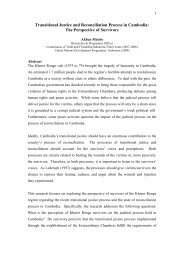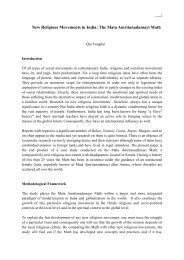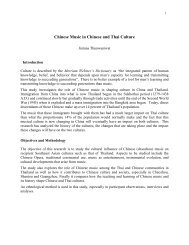Private Sector Participation in Affirmative Action in Malaysia: - Asian ...
Private Sector Participation in Affirmative Action in Malaysia: - Asian ...
Private Sector Participation in Affirmative Action in Malaysia: - Asian ...
Create successful ePaper yourself
Turn your PDF publications into a flip-book with our unique Google optimized e-Paper software.
Such glar<strong>in</strong>g disparities <strong>in</strong> wealth among ethnic groups and particularly severe Malay<br />
underrepresentation <strong>in</strong> ever expand<strong>in</strong>g corporate sector had become the ma<strong>in</strong> source of<br />
ethnic tensions and full blown conflicts. As number of Malays <strong>in</strong> urban space with<br />
tertiary education swelled, they were <strong>in</strong>creas<strong>in</strong>gly becom<strong>in</strong>g restive as opportunities <strong>in</strong><br />
private sector were hard to be found for them. Therefore, frustration of this group were<br />
directed aga<strong>in</strong>st the Ch<strong>in</strong>ese. Despite the fact that foreigners still dom<strong>in</strong>ated the private<br />
sector <strong>in</strong> <strong>Malaysia</strong>, Ch<strong>in</strong>ese became soft target as they were often visible <strong>in</strong> many of the<br />
key sectors and were often <strong>in</strong> direct deal<strong>in</strong>g with Malays on day today works. Some of<br />
these tensions and other political power struggles between these ethnic groups led to a<br />
worst ever ethnic riots <strong>in</strong> 1969. And 1969 riots became turn<strong>in</strong>g po<strong>in</strong>t <strong>in</strong> terms of<br />
affirmative action.<br />
Table 1 Employment by Occupation and ethnic group, 1970 (% of ethnic representation<br />
<strong>in</strong> occupation)<br />
<strong>Sector</strong> Malay Ch<strong>in</strong>ese Indian<br />
Professional & Technical 47.2 37.7 12.7<br />
Adm<strong>in</strong>istrative & Managerial 22.4 65.7 7.5<br />
Clerical workers 33.4 51.0 14.3<br />
Sales 33.4 64.7 11.0<br />
Production workers 31.3 59.9 8.6<br />
Service Workers 42.9 42.5 13.4<br />
Agricultural workers 68.7 20.8 9.6<br />
Source: Third <strong>Malaysia</strong>n Plan, 1976.<br />
New Economic Policy and the <strong>Private</strong> <strong>Sector</strong><br />
In the backdrop of grow<strong>in</strong>g ethnic disparities and severe Malay underrepresentation <strong>in</strong> the<br />
modern sectors of economy which many believed triggered the worst racial riots <strong>in</strong> 1969,<br />
the rul<strong>in</strong>g coalition which was overwhelm<strong>in</strong>gly dom<strong>in</strong>ated by the ethnic Malays<br />
<strong>in</strong>troduced most radical affirmative policies under the banner of New Economic Policy<br />
(NEP) <strong>in</strong> 1971. The NEP had two pronged strategies: eradicate poverty irrespective of<br />
10







